The OECD (Organisation for Economic Co-operation and Development) has recently published unemployment rates for its member countries. Mexico fares quite well; its rate of “open unemployment” so far this year has hovered around 5.5%. This is quite encouraging, since the average for the 31 OECD countries is around 8.7%. Note that these figures do not […]
Soil science and Mexico’s ancient kitchens
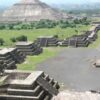
In an earlier post, we saw how archaeologists have gradually unraveled the history of the domestication of Mexico’s most important food plants. Other archaeologists, working at Teotihuacan, close to Mexico City, have been turning their attention away from how the upper classes lived (and ruled) to focus on the lives of the ordinary residents of […]
The impact of NAFTA on urban growth in Mexico
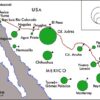
The North American Free Trade Agreement (NAFTA), signed in 1994, had a significant impact on the pace and pattern of urbanization in Mexico. NAFTA removed tariffs on imported corn and beans. Small Mexican producers could not compete with the cheap imports from the USA. As a result, an estimated 1.3 million agricultural jobs in Mexico […]
Mexico’s first cooks and the origins of Mexican cuisine

Mexican cuisine has been one of the country’s most successful cultural exports over the past twenty years or so and most large towns in North America and Europe now boast at least one Mexican restaurant, even if the menu is not necessarily “authentic”. For those wanting to experiment, the basic ingredients for Mexican meals can […]
The nationwide figure for 2004 was 26 / 100,000 inhabitants. By way of comparison, the rates in the USA, Canada, and the UK were about 6, 2 and 2 respectively. The latest figures show that South Africa has a rate of 39 and Colombia 38. The ten states with the worst murder rate in Mexico […]
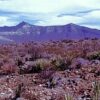
Thousands of dinosaur bones have been found in northern Mexico. Bones literally litter the ground. Here’s a femur; there’s a tibia; vertebrae, ribs, skulls… Dozens of dinosaurs have been unearthed in a broad belt across northern Mexico, from Baja California and Sonora in the west, through Chihuahua, and Coahuila to Nuevo León and Tamaulipas in […]
Want to show off your Spanish language skills? Try learning this Spanish-language tongue-twister related to San Juan Parangaricutiro, a town that was destroyed by Paricutín Volcano: El arzobispo de Parangaricutirimícuaro se quiere desarzobispoparangaricutirimicuarizar ¡el que lo desarzobispoparangaricutirimicuarizare, un buen desarzobispoparangaricutirimicuarizador será! The inhabitants of San Juan Parangaricutiro won a UN Development Prize. For a more […]
A small village in Mexico won a 2004 UN Development Prize

Every two years, the United Nations Development Programme (UNDP) awards the Equator prize (worth 30,000 dollars) to communities that have shown “outstanding achievement in the reduction of poverty through the conservation and sustainable use of biodiversity.” One of the winners of the 2004 Equator prize was the indigenous community of Nuevo San Juan Parangaricutiro, in […]
Evolution of control on the Yucatán Peninsula
Throughout history the Yucatán Peninsula has been somewhat separate from the rest of Mexico. The pre-Colombian Maya civilizations were more closely linked to Guatemala and Central America than to central Mexico. It took the Spaniards and Mexicans almost 400 years to gain full control of the Peninsula. In the 16th century, the Conquistadors needed about […]
Compared to its very large and loud northern neighbor the USA, Mexico often seems like a rather minor country. But let’s take a closer look at Mexico’s major characteristics. Mexico is among the world leaders in land size, population and economic production. These three criteria are a rational way of determining the world’s major countries. Mexico […]
Many Mexican place names were changed following Mexican Independence (1821)
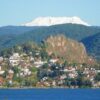
This is the fourth and final part of our series of guest blogs by Fatimah Araneta. Fatimah Araneta grew up in Mexico City. After gaining a Masters in City Planning at Berkeley, California, she opted to eschew city life and direct her energy and attention to living in tune with what’s left of Mother Earth […]
On January 1, 1846, the Criollo leaders in Merida declared independence as the Republic of the Yucatán for the third time. In 1847, the Caste War broke out when the Mayas rebelled against the Criollo upper class that controlled the Yucatán Republic. They drove most of the Criollos out of the Peninsula except for the those […]
The cultural geography of Mennonite enclaves in Mexico

Among the first Mennonite settlers were a group of more than 1300 families (about 9300 individuals) of German-Russian descent who arrived from Canada in 1922. They had been guaranteed tax concessions, freedom of worship and exemption from military service by President Obregón. At the time the Mexican government wanted to encourage more settlement in northern […]
The Spanish arrive and change lots of place names

This is the third in our series of guest blogs by Fatimah Araneta. Fatimah Araneta grew up in Mexico City. After gaining a Masters in City Planning at Berkeley, California, she opted to eschew city life and direct her energy and attention to living in tune with what’s left of Mother Earth before it all […]
Mexico’s population will peak before 2050 but migration is harder to predict

Past data and current trends indicate that Mexico is adhering to the demographic transition model (see post of 15 May 2010). Death rates first dropped precipitously and now birth rates are declining rapidly. By the middle of the 21st century, these will be roughly equal and natural population growth will drop to zero. Then birth […]
Is the BP Deepwater Horizon accident the biggest Gulf of Mexico oil spill in history?

Judging from the recent coverage in the US and world media, most people would immediately respond “Yes!”, citing the current BP spill resulting from the April 20 explosion of the Deepwater Horizon offshore rig. However, at present this would not be the correct answer. The largest oil spill in the Gulf of Mexico followed the […]
The Republic of the Yucatán
After independence in 1821, the Federated Republic of Yucatán joined the Mexican federation in May 1823. The new republic comprised the whole Yucatan Peninsula including what is now the states of Campeche and Quintana Roo. It maintained a degree of autonomy in the Mexican federation. In the mid 1830s President Santa Anna imposed a centrally […]
Mexican place names often have their roots in pre-Hispanic languages and have multiple levels of meaning

This is the second in our series of guest blogs by Fatimah Araneta. Fatimah Araneta grew up in Mexico City. After gaining a Masters in City Planning at Berkeley, California, she opted to eschew city life and direct her energy and attention to living in tune with what’s left of Mother Earth before it all […]
How Mexico’s fourth highest peak got its name
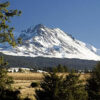
We are delighted to publish a series of guest blogs by independent researcher Fatimah Araneta. Fatimah Araneta grew up in Mexico City. After gaining a Masters in City Planning at Berkeley, California, she opted to eschew city life and direct her energy and attention to living in tune with what’s left of Mother Earth before […]
How big is Lake Chapala?
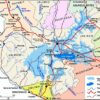
“How big is Lake Chapala?” There is no single answer to this question. It all depends on the reference point in time. Some geologists suggest that 40,000 years ago, the Lake’s surface area was seven times its current size and its volume about 200 times greater. At that time, the Lake towered almost 700 feet […]
Aguascalientes’ geopolitical romance and long road to Statehood

How did the State of Aguascalientes come to be so small, and sandwiched between much larger states? The area that is now the State of Aguascalientes was caught between the colonial jurisdictions of Jalisco and Zacatecas. Prior to the Mexican Revolution it was considered part of Zacatecas, but after the War of Independence, in 1821 […]
The origin of tequila

Mexico’s favorite “tipple” has a long and fascinating history. Historians have debated for years precisely when the spirit was first distilled, and precisely where this took place. John Pint, writing in MexConnect, has written a great article about the area around the town of Tequila (Jalisco), the heartland of tequila production. He presents a strong […]
Corner stores in Mexico give way to supermarket chains

In the past 50 years, Mexico has become a land of supermarkets. Where small corner stores once used to be the source of staples such as bread, milk and fresh vegetables, supermarkets have now taken over in almost every town. Here is a summary of Mexico’s main supermarket chains: * Wal-Mart de México (Walmex), easily […]
The short-lived Republic of the Río Grande

Leaders in the northern Mexican states of Coahuila, Nuevo León and Tamaulipas met in Laredo on 17 January 1840 and declared independence as the Republic of the Río Grande. They hoped to gain independence from the central Mexican government as Texas had done in 1836. Unfortunately for the infant republic, the state legislatures in the […]
A summary of population trends in Mexico

The Economist issue of April 24-30 had an interesting article entitled “Mexico’s population, when the niños run out. A falling birth rate and what it means.” Here are some of the figures quoted in that article: Children per woman of child-bearing age. 1960s: almost 7 today: just over 2 (about the same as the USA) […]
Listen to Geo-Mexico author on KMEXRadio.fm
KMEXRadio.fm has broadcast an interview with Richard Rhoda, the lead author of Geo-Mexico: the geography and dynamics of modern Mexico. The interview, by Amigo Rodrigo, first aired at 8:15 AM Central Daylight Time (CDT) on Wednesday May 26, and will air again later today (Wednesday May 26) at 6:15 PM CDT (that’s 7:15 Eastern, 5:15 […]
The pros and cons of bottled water

Mexico has overtaken Italy to become the world’s largest consumer of bottled water and now accounts for 13% of all the bottled water sold worldwide. The latest report of the Beverage Marketing Corporation puts the per person consumption of bottled water in Mexico at 234 liters a year. The equivalent figures for Italy, Spain and […]

The growth of Protestantism in Mexico has been rapid among low income groups, particularly in poor states and indigenous areas. Many of these gains are considered less a conversion from true Catholicism than a first time acceptance of a modern religion by people who previously adhered to Indian Folk Catholicism. Protestantism, and especially Pentecostalism, is […]
Is Mexico’s population evenly distributed?
No! Mexico’s population (mid-2010 estimate: 108,396,211) is not evenly distributed. Parts of central Mexico are very densely populated while there are relatively few people in the wide open spaces in northern Mexico. This is perhaps one of the most important features of Mexico’s human geography. The Federal District and adjoining State of Mexico make up […]

Life expectancy in most European countries has increased steadily over the past couple hundred years at a rate of about 2.5 years per decade (25 years per century). In the developing world, the increase has been higher, between 3 and 5 years per decade. In Mexico, life expectancy in the 1930s was only 37 years. […]